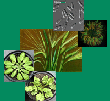| Silva, B; Lehnert, L; Roos, K; Fries, A; Rollenbeck, R; Beck, E; Bendix, J: Mapping two competing grassland species from a low-altitude helium balloon. in IEEE Geoscience and Remote Sensing Society: IEEE Journal of Selected Topics in Applied Earth Observations and Remote Sensing, 7, 1939-1404 (2014), doi:https://doi.org/10.1109/JSTARS.2014.2321896 | |
| Abstract: his paper describes a method of low-altitude remote sensing in combination with in situ measurements (leaf area, spectroscopy, and position) to monitor the postfire canopy recovery of two competing grassland species. The method was developed in the Andes of Ecuador, where a tethered balloon with a digital camera was deployed to record a time series of very high spatial resolution imagery (nominal resolution=2 cm ) of an experimental plot covered by two competing species: 1) the pasture grass, Setaria sphacelata; and 2) the invasive southern bracken, Pteridium arachnoideum. Image processing techniques were combined to solve geometric issues and construct high-quality mosaics for image classification. The semiautomatic and object-oriented classification method was based on geometrical and textural attributes of image segments and showed promising results for detecting the invasive bracken fern in Setaria pastures (performance by area under the curve, AUC = 0.88). Valuable insights are given into vegetation monitoring applications using unmanned aerial vehicles, which produces a time series of species-specific maps, including foliage projective cover (FPC) and leaf area index (LAI). This new method constitutes an important and accessible tool for ecological investigations of competing species in pastures and validation of remote sensing information on mountain environments. |

